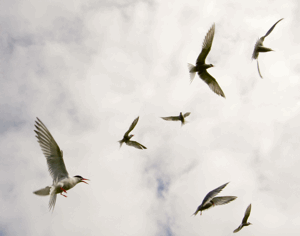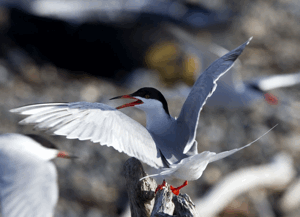Tern, Tern, Tern
Air Date: Week of September 3, 2010

(Salt Marsh Diary ©)
A tern, on the hunt for food, is a determined seabird. And a mother tern is even more determined when her mission is to feed and protect her young. Mark Seth Lender offers his observations.
Transcript
YOUNG: The terns that live on America’s Atlantic coast are in trouble. The meager habitat that remains to them, beaches and a few near-shore islands are highly vulnerable to human disturbance, especially during breeding season. Scientists say the best thing people can do for terns is leave them alone. And if you do – as writer Mark Seth Lender found – sometimes terns will return the favor.
LENDER: Tern hovers, then tumbles from the sky. “X” marks the spot where she enters, a cross made of the splash of her spray and the splice of her wings. Beneath lies Sunken Treasure. She alone knows what to Seek and where to Find.

Terns flying. (Salt Marsh Diary ©)
Tern rises from the dark surface, her body shaped now like a “V” and mirrored in the V-shaped wake of water that strays behind her. “V” for Victory, though of all the boot’ and bounty of the sea, only a single silver minnow flashes in her bright orange beak.

(Salt Marsh Diary ©)
Tern does not spend her meager winnings but holds, as if to savor. Tern tacks toward land. Others of her kind hail and sometimes join her. Just offshore they come to rest on a buoy or piling, a transient place of mooring. Elaborate conversations ensue, words of greeting, sometimes angry warnings to gull or cormorant who’ve come too close. It is a warning heeded: Though all of these are many times larger none dares approach these pirated roosts which terns have chosen for their own.

Mother tern and child. (Salt Marsh Diary ©)
Tern ignores them all. She talks to no one. Her destination guarded. Her council recorded only to herself until she hears among all others the one voice that is her Polar Star. Upon a waste of pebbles and shells one waits lonely. It is her daughter, fledged but dependent on her. The features of the childbird softer. Plumage indistinct as if to hide her. In plain sight only her mother finds her and feeds her with a kiss, bill to beak. Then leaves, to seek what other valuables lie out on the shoals of the deeps.

(Salt Marsh Diary ©)
And Daughter cries as if she will never see Mother again. As if she knows. Then Child Tern’s worst fear comes true: The day is coming when fledgling by herself learns to fend, alone, or perish…
[TERNS CALLING]
YOUNG: Mark Seth Lender’s forthcoming book is, “Salt Marsh Diary, A Year on the Connecticut Coast.” He also takes photographs of the wildlife he observes. You can see some great shots at our website, L-O-E dot org.
Links
Living on Earth wants to hear from you!
Living on Earth
62 Calef Highway, Suite 212
Lee, NH 03861
Telephone: 617-287-4121
E-mail: comments@loe.org
Newsletter [Click here]
Donate to Living on Earth!
Living on Earth is an independent media program and relies entirely on contributions from listeners and institutions supporting public service. Please donate now to preserve an independent environmental voice.
NewsletterLiving on Earth offers a weekly delivery of the show's rundown to your mailbox. Sign up for our newsletter today!
 Sailors For The Sea: Be the change you want to sea.
Sailors For The Sea: Be the change you want to sea.
 The Grantham Foundation for the Protection of the Environment: Committed to protecting and improving the health of the global environment.
The Grantham Foundation for the Protection of the Environment: Committed to protecting and improving the health of the global environment.
 Contribute to Living on Earth and receive, as our gift to you, an archival print of one of Mark Seth Lender's extraordinary wildlife photographs. Follow the link to see Mark's current collection of photographs.
Contribute to Living on Earth and receive, as our gift to you, an archival print of one of Mark Seth Lender's extraordinary wildlife photographs. Follow the link to see Mark's current collection of photographs.
 Buy a signed copy of Mark Seth Lender's book Smeagull the Seagull & support Living on Earth
Buy a signed copy of Mark Seth Lender's book Smeagull the Seagull & support Living on Earth

